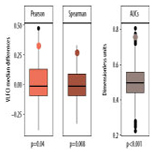Non-Invasive Chronic Asymptomatic Chagas Disease Screening Through High-Resolution Electrocardiography (ECG)
Ezequiel de la Rosa, Patricia Paglini-Oliva, Laura Prato, Cristobal Fresno, Peter Willshaw, Elmer Andrés Fernandez
Med Sci Tech 2017; 58:77-86
DOI: 10.12659/MST.905455
Available online: 2017-08-01
Published: 2017-08-01

BACKGROUND:
Chagas disease (ChD) has become a global health problem with more than eight million people infected worldwide. Its asymptomatic form (ACD) is still a challenge for clinicians since patients are rarely detected at this stage and evolve undiagnosed to severe determined forms of the disease, thus becoming a source of non-vectorial transmission. We have developed a non-invasive methodology to detect ACD individuals from healthy ones through surface ECG records.
MATERIAL AND METHODS:
We studied 135 high-resolution ECG records (19 non-Chagasic, 39 ACD and 77 with other ChD classification) by means of a new non-invasive index called the “very-low-frequency correlation index”, VLFCI. It is obtained from frequency domain analysis of RR and QRS complex duration time series. Using the VLFCI, a discriminant rule for ACD subjects prediction was developed, tested, and evaluated over all ChD subjects.
RESULTS:
Significant differences (p<0.05) were found between Chagasic and healthy groups when comparing VLFCI data. All ChD groups obtained greater median VLFCI values than the control. The VLFCI-based discriminant rule achieved 69% sensitivity, 63% specificity, and a 79% positive predictive value when testing non-Chagasic subjects against those with ACD. Moreover, a 70% classification rate was achieved when validating the discriminant rule over the entire Chagasic dataset.
CONCLUSIONS:
To the best of our knowledge, this is the first work in which ACD subjects were identified using surface ECG. The method allowed non-invasive ACD prediction and could potentially be implemented in low-cost portable devices for massive ChD screening.
Keywords: Diagnosis, Computer-Assisted, Electrocardiography, Spectral Karyotyping



